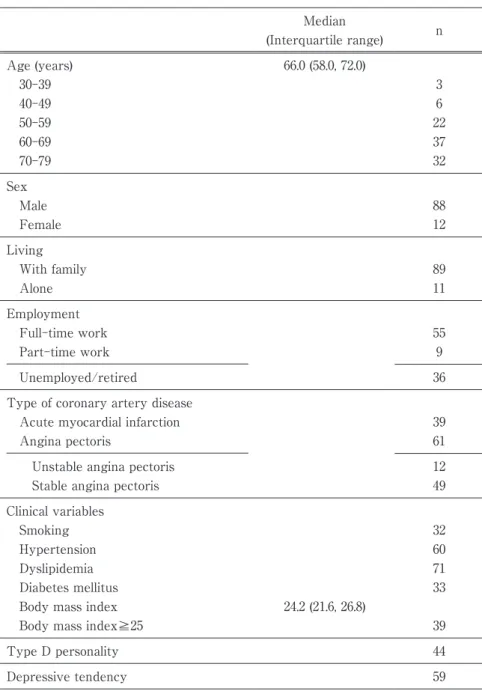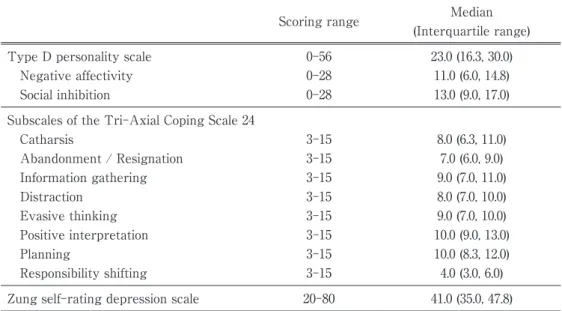Ⅰ Introduction
The Global Burden of Disease Study has demon‑
strated that cardiovascular diseases are leading causes of death in the world
1)and also in Japan
2). Coronary artery disease (CAD), a mainstay of athero‑
sclerotic cardiovascular disease, could be attributed in Japan to the westernization of lifestyles, an in‑
creasingly high-stress society, a super-aging popula‑
tion, and the work-centered way of life. While strate‑
gies for percutaneous coronary intervention (PCI) have been established, interventions for psychosocial stress and illness are still needed to prevent further major cardiovascular events in patients with CAD.
The prevalence of depression is strikingly higher among patients with acute myocardial infarction (45
%) than among the general population (2-3 % in males, 5-9 % in females)
3)4). Importantly, the mortality rate after two years among depressive CAD patients has been twice as high as non-depressed CAD patients
5).
Assessment of Depressive Tendency, Coping Strategies, and Type D Personality in Japanese Patients
with Coronary Artery Disease
Daisuke Y
amaguchi, Atsushi I
zawa*and Yasuko M
atsunagaSchool of Health Sciences, Shinshu University
Background : Type D personality, characterized by social inhibition and negative affectivity, is a psychological risk of coronary artery disease (CAD). This study aims to identify self-ratings of depression and its associations with coping strategies, Type D personality, and with sociodemographic or clinical factors among Japanese patients with CAD.
Methods : Participants were CAD patients who underwent percutaneous coronary intervention. The Zung Self- Rating Depression Scale, the Type D Personality Scale, and the Tri-axial Coping Scale 24 were used to survey the presence of depressive tendency, Type D personality, and type of coping strategy, respectively. Logistic re‑
gression analysis was performed to identify characteristics associated with depressive tendency.
Results : Among 100 respondents who returned fully completed questionnaires (effective response rate : 92.6 %), 59 were found to be depressed, and 44 presented with Type D personality. The self-ratings of depression were significantly associated with Type D personality (odds ratio [OR]=2.78, 95 % confidence interval [CI] [1.06, 7.24], P=0.037), and inversely associated with full-time work (OR=0.23, 95 % CI [0.08, 0.64], P=0.005). Analysis of the types of coping strategy revealed that abandonment or resignation coping style was significantly associated with depressive tendency (OR=1.33, 95 % CI [1.07, 1.65], P=0.010).
Conclusions : CAD patients with higher depressive tendency are significantly more likely to display a Type D personality, to employ abandonment or resignation coping strategies, and are less likely to be in full-time em‑
ployment. Employment of strategies to prevent negative coping behavior could be beneficial to prevent future depressive tendency in CAD patients with Type D personality. Shinshu Med J 68 : 97―105, 2020
(Received for publication July 3, 2019 ; accepted in revised form October 25, 2019) Key words : Type D personality, Depressive tendency, coping strategies, coronary artery disease
Abbreviations : CAD, coronary artery disease ; PCI, percutaneous coronary intervention ; SDS, Self-Rating De‑
pression Scale
* Corresponding author : Atsushi Izawa
School of Health Sciences, Shinshu University, 3-1-1 Asahi, Matsumoto, Nagano 390-8621, Japan E-mail : izawa611@shinshu-u.ac.jp


